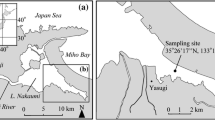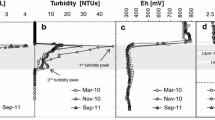Abstract
The artificial tracer sulphur hexafluoride (SF6) has been used to study the density-driven deep water exchange between two sill-separated basins of Lake Lucerne, Gersauersee and Urnersee. The sources of the density gradients between the two basins are (1) salinity differences between the major inlets due to the different geology of their drainage areas, and (2) temperature differences due to spatial variation of wind forcing. Wind speeds are generally larger in Urnersee, especially in spring during the so-called Föhn events, when winds blow from the south. In contrast, Gersauersee is protected form these winds. In spring 1989, a total of 630 g of SF6 was released at 80 to 120 m depth in the small Treib Basin located between Urnersee and Gersauersee. During about 100 days the distribution of SF6 in the lake was determined by gaschromatography. Two models are used to quantify the exchange flow, (1) a one-box mass balance model for SF6 in the deep part of Treib Basin, and (2) a one-dimensional diffusion/advection model describing the temporal and vertical temperature variation in Urnersee. According to the first model, the flow into the deep hypolimnion of Urnersee, decreases from 21·106 m3·d−1 at the end of March to about 8·106 m3·d−1 in late April. The second model yields similar flow rates. The decrease of the flow rate during spring, confirmed by both approaches, is consistent (1) with the decreasing strength of the density gradient above the sill during spring and early summer, and (2) with hydrographic information collected in Lake Lucerne during other years.
Similar content being viewed by others
References
Aeschbach-Hertig, W., R. Kipfer, M. Hofer and D. M. Imboden, 1996. Density-driven exchange between the basins of Lake Lucerne (Switzerland) traced using the3H−3He method. Limnol. Oceanogr. 41:707–721.
Farmer, D. M. and L. Armi, 1986. Maximal two-layer exchange over a sill and through a combination of a sill and contraction with barotropic flow. J. Fluid Mech. 164:53–76.
Landeshydrologie und-geologie, 1995. Hydrologisches Jahrbuch der Schweiz, 1994, BUWAL, Bern (Switzerland).
Imboden, D. M. and A. Wüest, 1995. Mixing mechanisms in lakes. In Lerman, A., D. M. Imboden and J. R. Gat (editors), “Physics and chemistry of lakes”, Springer, New York and Heidelberg: 83–138.
Ledwell, J. R., A. J. Watson and W. S. Broecker, 1986. A deliberate tracer experiment in Santa Monica Basin. Nature 323:322–324.
Ledwell, J. R. and A. J. Watson, 1991. The Santa Monica Basin tracer experiment: A study of diapycnal and isopycnal mixing. Geophys. Res. 96:8695–8718.
Ledwell, J. R., A. J. Watson and C. S. Law, 1993. Evidence for slow mixing across the pycnocline from an open-ocean tracer release experiment. Nature 364:701–703.
Ledwell, J. R. and A. Bratkovich, 1995. A tracer study of mixing in the Santa Cruz Basin. J. Geophys. Res. 100:20681–20704.
Maiss, M., J. Ilmberger and K. O. Münnich, 1994a. Vertical mixing in Überlingersee (Lake Constance) traced by SF6 and heat. Aquat. Sci. 56:329–347.
Maiss, M., J. Ilmberger, A. Zenger and K. O. Münnich, 1994b. A SF6 tracer study of horizontal mixing in Lake Constance. Aquat. Sci. 56:307–328.
Maiss, M. and I. Levin, 1994. Global increase of SF6 observed in the atmosphere. Geophys. Res. Lett. 21:569–572.
Schlatter, J., 1991. Schwefelhexafluorid als Tracer zum Studium von Mischungsprozessen in Seen. Ph. D. Diss. no. 9596, ETH, Zurich, 148 pp.
Schlatter, J., M. Hofer and D. M. Imboden, 1990. Die Verwendung von Schwefelhexafluorid zum Studium von Transportprozessen in Seen. Gas-Wasser-Abwasser 70:36–42.
Singh, H. B., L. J. Salas and L. A. Cavanagh, 1977. Distribution, sources and sinks of atmospheric halogenated compounds. Journal of the Air Pollution Control Association 27:332–336.
Van Senden, D. C. and D. M. Imboden, 1989. Internal seiche pumping between sill-separated basins. Geophys. Astrophys. Fluid Dyn. 48:135–150.
Van Senden, D. C., R. Portielje, A. Borer, H. Ambühl and D. M. Imboden, 1990. Vertical exchange due to horizontal density gradients in lakes; the case of Lake Lucerne. Aquat. Sci. 52:381–398.
Wanninkhof, R., 1992. Relationship between wind speed and gas exchange over the ocean. J. Geophys. Res. 97:7373–7382.
Wanninkhof, R., J. R. Ledwell and W. S. Broecker, 1985. Gas exchange-wind speed relation; measured with sulfur hexafluoride on a lake. Science 227:1224–1226.
Wanninkhof, R., J. R. Ledwell and W.S. Broecker, 1987. Gas exchange on Mono Lake and Crowley Lake, California. J. Geophys. Res. 92:567–580.
Wanninkhof, R., J. R. Ledwell and A.J. Watson, 1991. Analysis of sulfur hexafluoride in seawater. J. Geophys. Res. 96:8733–8740.
Wanninkhof, R. and L. F. Bliven, 1991. Relationship between gas exchange, wind speed, and radar backscatter in a large wind-wave tank. J. Geophys. Res. 96:2785–2796.
Watson, A. J., J. R. Ledwell and S. C. Sutherland, 1991. The Santa Monica Basin tracer experiment: Comparison of release methods and performance of perfluorodecalin and sulfur hexafluoride. J. Geophys. Res. 96:8719–8725.
Watson, A. J., M. I. Liddicoat and J. R. Ledwell, 1987. Perfluorodecalin and sulphur hexafluoride as purposeful marine tracers: some deployment and analysis techniques. Deep-Sea Res. 34:19–31.
Wüest, A. 1987. Ursprung und Grösse von Mischungsprozessen im Hypolimnion natürlicher Seen. Ph.D. Diss. no. 8350, ETH, Zurich. 144 pp.
Wüest, A., D. M. Imboden and M. Schurter, 1988. Origin and size of hypolimnic mixing in Urnersee, the southern basin of Vierwaldstättersee (Lake Lucerne). Schweiz. Z. Hydrol. 50:40–70.
Wüest, A., D. C. Van Senden, J. Imberger, G. Piepke and M. Gloor, 1996. Comparison of diapycnal diffusivity measured by tracer and microstructure techniques. Dyn. Atmos. Oceans. 24:27–39.
Author information
Authors and Affiliations
Rights and permissions
About this article
Cite this article
Schlatter, J.W., Wüest, A. & Imboden, D.M. Hypolimnetic density currents traced by sulphur hexafluoride (SF6). Aquatic Science 59, 225–242 (1997). https://doi.org/10.1007/BF02523275
Received:
Accepted:
Issue Date:
DOI: https://doi.org/10.1007/BF02523275




